Patrick Williams | kind of built
built



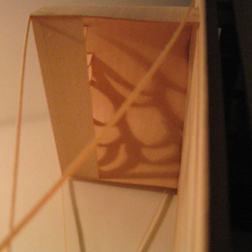

I built this model from basswood and glue between two consecutive Wednesdays (1 September 2004 and 8 September 2004) primarily using three areas of my apartment: the kitchen, the living room, & my office. The week previous was spent conceptualizing the process I was to undertake and familiarizing myself with the work to serve as the basis for the model.
The model is based on a 1944 work by Charles Seliger (Organic Form).
This webpage serves as documentation of my process in building the model.
This was my first experience working in basswood, and I was a somewhat nervous about it. My process in building the model reflected this; I simultaneously began to exploring the Seligman piece and experimenting with the materials on (seemingly) unrelated small models. I soon discovered that I learned from the basswood informed my approach to the painting, and vice versa. I learned several other things as well; these things are discussed below.
View:
My Approach:
[top of page]









I began by exploring and describing the image, at the same time making lists of potential attributes of a for a model that would relate/describe/embody/defy it. Among these attributes:
- emphasize walls, braces, cables, supports
- preserve curves
- deep/confined spaces
- cells, supports, wing
- eaves, overhangs
- focus on barriers
- ornate boundaries
Additionally, I stated some structural goals for the model; things I considered interesting analogues to parts of the model:
- contrast among views
- starkness
- noncongruent spaces
- spaces deep enough to create darkest areas
- steeple?
I visited the 6th floor copy room in Perry-Castaneda Library near 6pm on Friday 27 August 2004 and made $6 worth of copies of the image. I employed several strategies to distort and reframe the image and its components. Among them:
- reduction & enlargement
- multi-generation replication to increase noise in the image
- movement of image during copy process
- combining of components of the image at different scales and orientations
These strategies, as well as increasing my experience with the image, helped me to formulate several questions using it to build my model.
how wd this look tall?
reverse that?
what suggests boundaries/flow?
surfaces?
what is obscured? by what?
The photocopies helped me to find spaces within the image that seemed separate, hidden, isolated; I imagined myself as a tiny inhabitant of the region of the image, unable to see any space but the one I in which found myself trapped. I imagined severe and intimidating shadows, like those that cut across faces and floors in movies about death row, as the only clues to the hidden features of the structure.
Words and Artifacts:
[top of page]






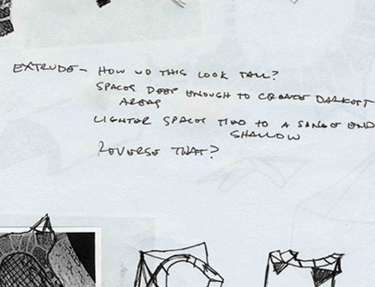
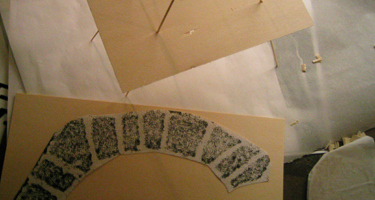
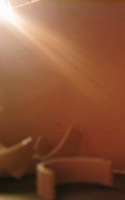


Next, I worked through these images, questions & strategies in my sketchbook and with the smallish pieces of basswood I was beginning to manipulate.
28.08.04
braces. friction.
extrude sections to build depth.
illusion of curve with slats.
29.08.04
wall-arch.
spaces around curved spaces.
steeple = leg.
30.08.04
slits.
slats.
slants.
slots.
splints.
block light through structure.
narrow.
01.09.04
jewel saw is tedious, but can make short curved pieces for floral part. then,
attach to side of structure. good for cutting slits.
tall
blank side
floral | cell walls to create shadows
slits, slats, slants
ear part
enclosed spaces
reinforce boundaries, cables
n.d.
accurate way to angle edges? sandpaper creates an inconsistent edge on pieces under an inch.
corner: erect a post. drape glue soaked thread.
contour/togographic ground
too suggestive?
pierce a plane with "lumber" shapes from UL corner?
scored, slotted.
Helpful Tools:
[top of page]



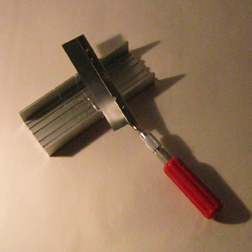
I used many tools throughout this process. Some were more helpful than others. Among the more surprising helpful ones:
- A bottle of 1998 Taylor Port that I received as a gift nearly a year ago served as a good frame for consistently shaped against-the-grain curves.
- Our broom did the same for with-grain curvature of flat basswood pieces for use in the shadow-casting screen piece of the model.
- A razor saw and miter box helped me to cut segments from broad curved pieces and to cut slanted edges.
- A cylindrical lamp served as a brace for more irregular convex curved pieces that, while cool, were not used in the model
Additionally, I found the following books helpful in their examples of joining techniques for modelmaking:
Janke, Rolf. (1978). Architectural models. New York : Architectural Book Pub. Co.
Knoll, Wolfgang. (1992). Architectural models : construction techniques. New York : McGraw-Hill.
Notable Events:
[top of page]


I cut my self twice during the production of this model. Both cuts occurred in the second week of the process on the same finger, the middle finger of my right hand. The earlier cut (1) healed more slowly than the second (2), though they received the same attention. Neither cut exceeded 1/4 inch, and both were caused by number 11 x-acto blades. Additionally, both cuts occurred very near to the first scar (3) I remember getting, from slicing my finger on a soup can at age 2.
The left basin of my kitchen sink was plugged and filled with water for the entire week. Every couple of days I dropped another few pieces of basswood into the water, and retrieved others from the water. I attempted to bend those pieces of basswood I retrieved, often unsuccessfully.
Features of the Model:
[top of page]

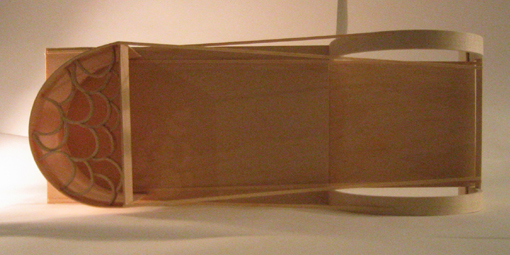






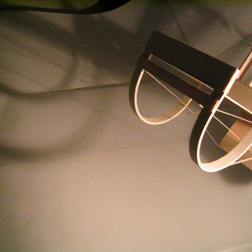
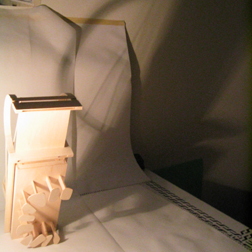

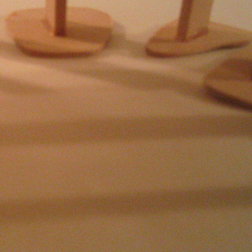



My focus and goals shifted several times throughout the construction of this model. I achieved many of my structural objectives, failed at many others, and abandoned yet others.
Facts:
- This model's dimensions are 15" x 5" x 6".
- This model weighs less than a pound.
- This model can stand on each of its edges, a fact that allows the viewer to explore it from a variety of perspectives, with a variety of its components visible.
- The various components of this model cast shadows both on the surface of the model and the surface upon which the model rests. Some of these shadows can be viewed in the images to the right.
Lessons Learned:
[top of page]

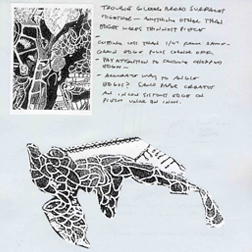

I learned more lessons than I can articulate through this process, both about the process itself and about other things. Among those I can articulate:
- Cutting less than 1/4" from same-grain edge pulls the corner off.
- This model reveals the superparanoiac within its creator.
- When glue is spread across a plane of basswood in order to affix it to another plane of basswood, the larger of the two tends to warp, unless placed between large books (volumes of the Physicians' Desk Reference, for example).
- Straight-up glue joints outperformed both matched-notch and mortise-style joints in my execution of this model.